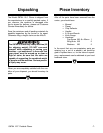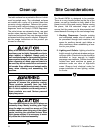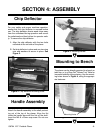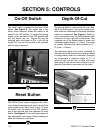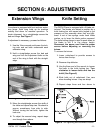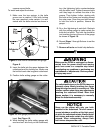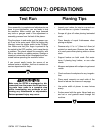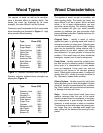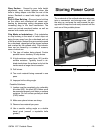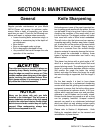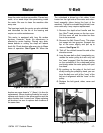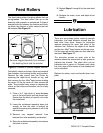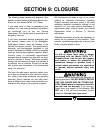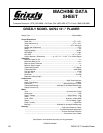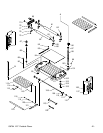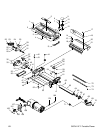
G8794 12
1
⁄2" Portable Planer
-15-
Wavy Surface - Caused by poor knife height
adjustment, wavy surface appears when one
knife is taking deeper cuts than the rest of the
knives. Recheck or reset knife height with the
gauge.
Pitch & Glue Build-up - Glue and resin build-up
on the rollers and cutterhead will cause over-
heating by decreasing cutting sharpness while
increasing drag in the feed mechanism. The
result can include scorched lumber as well as
uneven knife marks and chatter.
Chip Marks or Indentations - Chip indentation
or chip bruising is the result of wood chips not
being thrown away from the cutterhead and out
of the dust chute. Instead they are carried around
the cutterhead, deposited on the planed surface
and crushed by the outfeed roller. Chip indenta-
tions can be caused by a number of reasons,
some of which are:
1. The type of lumber being planed. Certain
species have a tendency to chip bruise.
2. A high moisture content (over 15%) and/or
surface moisture. Typically found in air-
dried stock where the surface is dry but the
inside needs a longer time to season.
3. Dull knives.
4. Too much material being removed in one
pass.
5. Improper knife cutting angle.
Possible Solutions:
1. Lumber must be completely dry, preferably
kiln-dried (KD). Air-dried (AD) lumber must
be seasoned properly and have no surface
moisture. Do not surface partially-air-dried
(PAD) lumber.
2. Make sure planer knives are sharp.
3. Remove less material per pass.
4. Use a smaller cutting angle or a double
bevel grind (consult a reputable knife
grinder).
Storing Power Cord
Figure 13. Convenient cord storage.
The underside of the outfeed extension wing con-
tains a convenient cord storage area. Just fold
the wing up, and wrap the cord around the stor-
age wires to keep the cord neatly stowed until the
next use of this portable planer.



